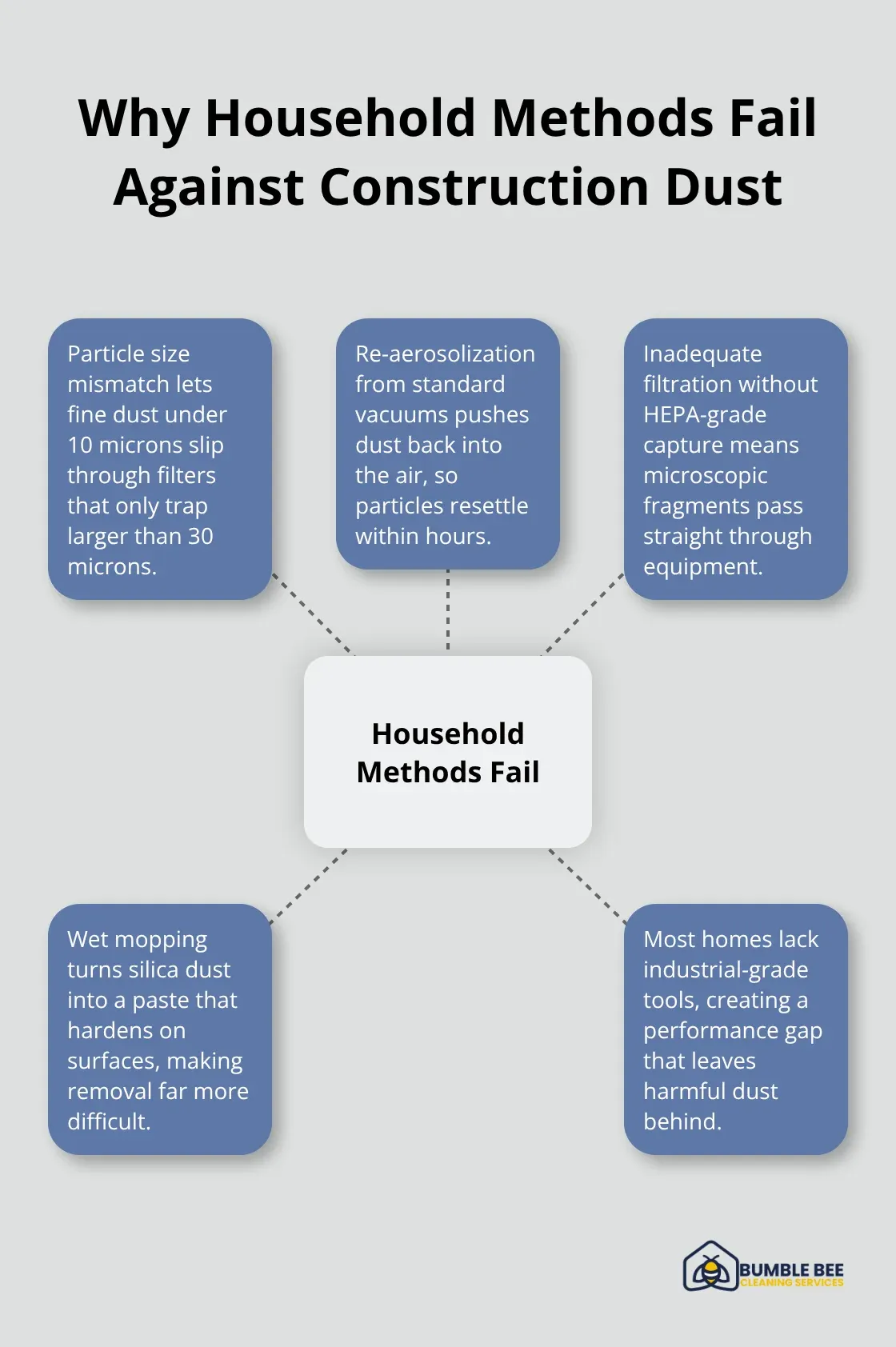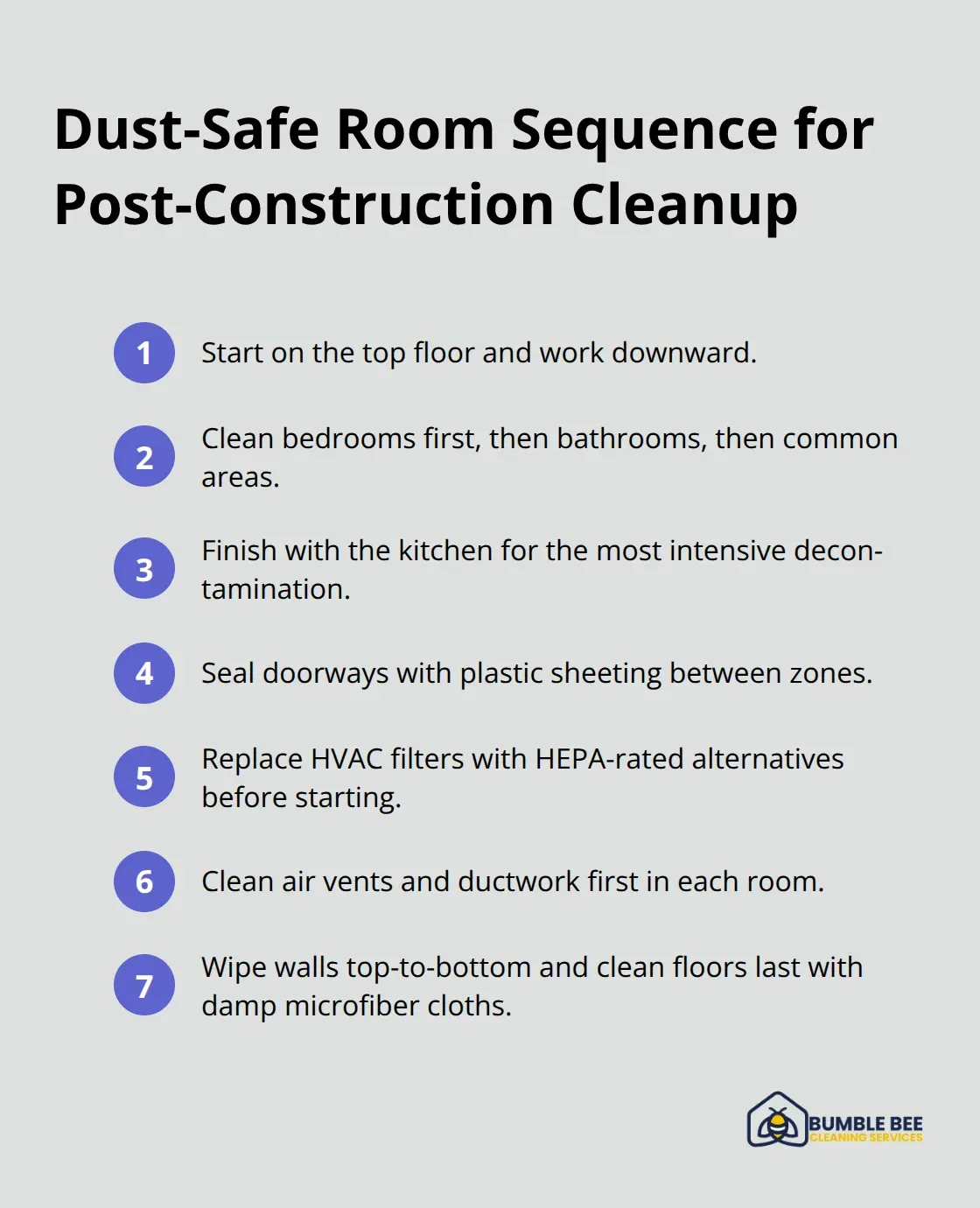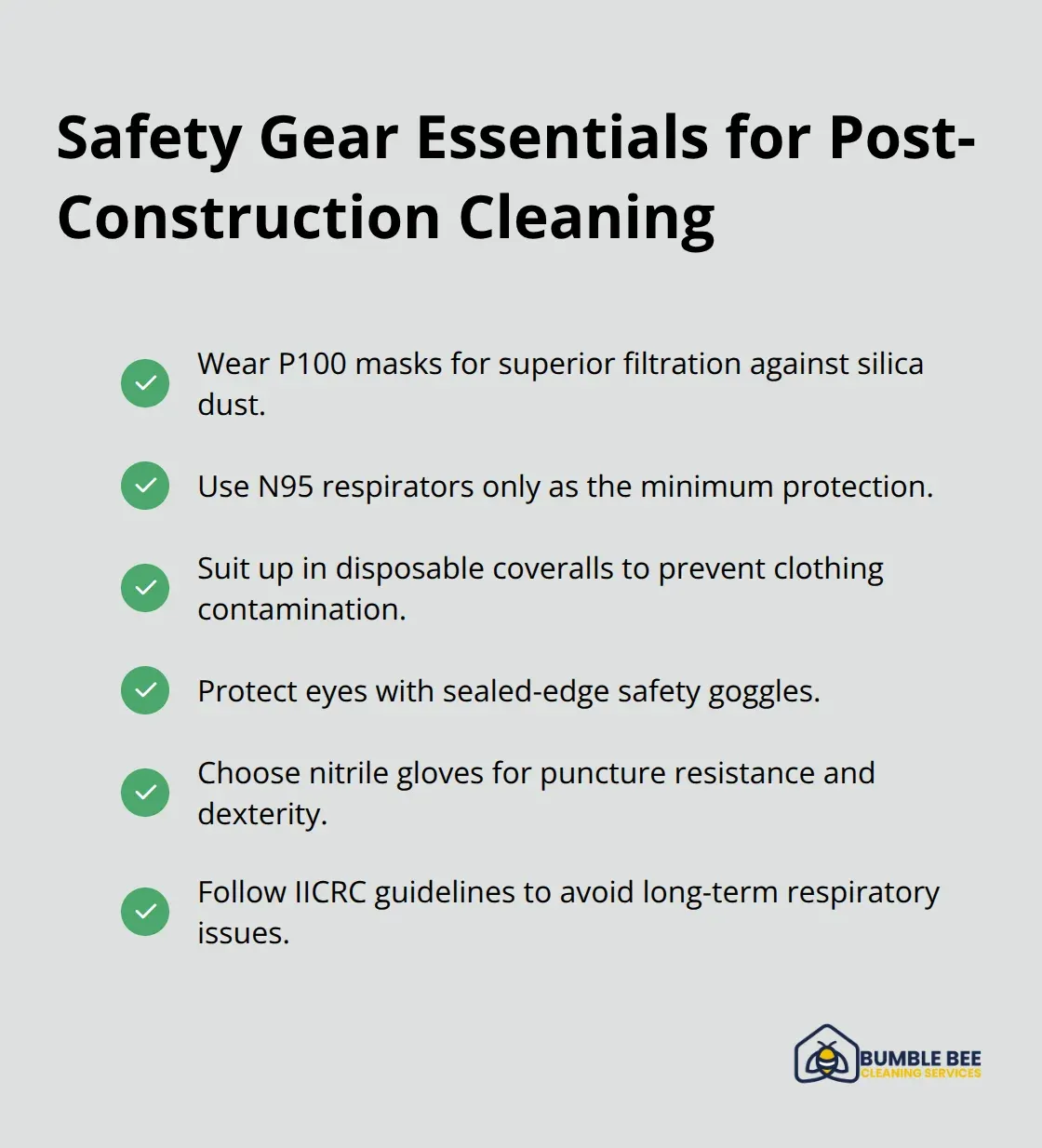Construction dust settles into every corner after home renovations, creating health hazards and stubborn cleaning challenges that standard methods can’t handle.
We at Bumble Bee Cleaning Services have tackled countless post-construction cleanups across Seattle homes. This guide reveals professional techniques to eliminate dust completely and restore your living space to pristine condition.
Understanding Post-Construction Dust Challenges
What Makes Construction Dust So Different
Construction dust contains far more than ordinary household particles. Silica dust from concrete and brick creates microscopic fragments that penetrate deep into your lungs, while drywall particles contain calcium sulfate that coats surfaces with a film regular methods cannot remove. Wood dust from cuts and sands combines with metal shavings from electrical work, creating a toxic mixture that settles into every crevice of your home. The Occupational Safety and Health Administration has set a permissible exposure limit of 50 micrograms of respirable crystalline silica per cubic meter of air over an 8-hour period, and 2 million workers in the construction industry face exposure to this dangerous dust that now fills your space.
Health Consequences You Cannot Ignore
The Environmental Protection Agency confirms that construction debris poses serious respiratory risks, including chronic bronchitis and potential lung cancer from prolonged exposure. Silica dust causes silicosis, a fatal lung disease that develops over years of exposure. Lead dust from older Seattle homes adds another layer of danger (causing systemic poisoning that affects multiple organ systems). Asbestos particles from pre-1980 construction materials can remain airborne for days, leading to asbestosis and lung cancer decades later. Your family breathes these particles every minute the dust remains in your home.
Why Your Vacuum Fails Against Construction Dust
Standard household vacuums push fine particles back into the air instead of capturing them. Construction dust particles measure less than 10 microns, while regular vacuum filters only trap particles larger than 30 microns. These microscopic fragments pass straight through conventional equipment and resettle within hours. HEPA filters remove 99.97% of airborne particles (but most homeowners lack access to industrial-grade equipment). Wet mops spread silica dust into a paste that hardens on surfaces, making removal even more difficult than before you started.

Professional-grade equipment becomes necessary when standard tools fail to address these unique challenges.
Essential Tools and Techniques for Dust Removal
Industrial HEPA Systems Beat Standard Vacuums Every Time
Industrial-grade HEPA vacuums capture particles as small as 0.3 microns, which makes them significantly more effective than household models against construction dust. Air scrubbers with three-stage filtration systems process large volumes of air per minute and remove airborne particles that standard equipment misses completely. Steam cleaners that operate at high temperatures dissolve the calcium sulfate film from drywall dust that cold water cannot touch. Professional cleaning services complete a thorough post-construction cleanup efficiently with this equipment, while DIY efforts take much longer with inferior results. Pressure washers remove concrete dust from exterior surfaces without damage to your home’s siding or windows.
Room Sequence Prevents Cross-Contamination
You should start cleanup from the top floor and work downward to prevent dust from resettlement in cleaned areas. Clean bedrooms first, then bathrooms, then common areas, and finish with the kitchen because food preparation surfaces require the most intensive decontamination. Seal doorways with plastic sheeting between cleaned and uncleaned rooms to prevent airborne particles from spread. Replace HVAC filters with HEPA-rated alternatives before you start any cleanup work. Clean air vents and ductwork first in each room, then walls from ceiling to floor, and floors last with damp microfiber cloths that trap particles instead of dispersal.
Safety Gear Protects Against Long-Term Health Damage
N95 respirators provide minimum protection, but P100 masks filter particles effectively and offer superior defense against silica dust exposure. Disposable coveralls prevent dust from contamination of your clothing and spread throughout your home. Safety goggles with sealed edges stop particles from eye irritation and permanent damage. Nitrile gloves resist punctures from sharp debris while they maintain dexterity for detailed cleanup tasks. The Institute of Inspection Cleaning and Restoration Certification provides internationally recognized guidelines for proper cleaning and restoration practices to avoid chronic respiratory issues that develop years after exposure.
When Professional Equipment Makes the Difference
Seattle’s unique climate conditions create additional challenges that require specialized approaches and equipment beyond standard household tools.
Seattle-Specific Considerations for Post-Construction Cleaning
Local Building Codes Create Unique Dust Challenges
Seattle’s building codes create unique dust challenges when materials get improperly sorted during demolition. The Seattle Department of Construction and Inspections mandates specific containment protocols for lead paint removal in pre-1978 homes, but these requirements often leave homeowners with concentrated dust pockets that standard methods cannot address. Washington State regulations also require HEPA filtration during asbestos abatement in older neighborhoods like Capitol Hill and Queen Anne, yet fine particles still escape into spaces through microscopic gaps in containment barriers.

Pacific Northwest Weather Transforms Dust into Cement
The Pacific Northwest’s high humidity levels cause construction dust to clump and stick to surfaces with adhesive-like properties that resist removal. Rain increases indoor moisture to 60-80%, which transforms silica particles into cement-like paste on walls and floors. Seattle’s frequent temperature fluctuations between 35-75 degrees create condensation cycles that drive dust deeper into porous surfaces like wood and drywall. Winter months with minimal ventilation trap particles indoors for extended periods, while summer wildfire smoke adds external particulates that compound construction debris. The National Air Duct Cleaners Association recommends duct maintenance every 3-5 years, but Seattle homes require immediate duct attention after construction due to these moisture-related complications that accelerate contamination.
Cedar and Concrete Dust Dominate Local Renovations
Seattle construction projects heavily feature Western Red Cedar, which produces aromatic oils that bind with other particles and create respiratory irritants that linger for months after completion. Concrete foundations and driveways generate crystalline silica at levels 30% higher than national averages due to local aggregate sources from the Cascade Mountains. Older Seattle homes contain Douglas Fir framing that releases tannins when disturbed (staining surfaces brown and requiring specialized solutions that household products cannot handle). Steel reinforcement in earthquake retrofits creates metal filings that standard magnets cannot collect effectively, demanding professional extraction equipment for safe removal.
Final Thoughts
Complete construction dust removal takes 3-7 days for a 2,000 square foot Seattle home, with professional cleaners finishing in 20-30 hours using industrial equipment. DIY efforts stretch into weeks with inferior results. Seattle’s high humidity makes construction dust particularly stubborn and requires specialized techniques that standard household equipment cannot handle effectively.

You should consider professional services when you deal with silica dust from concrete work, lead contamination in pre-1978 homes, or asbestos particles from older materials. After initial cleanup, replace HVAC filters monthly for the first three months, then return to your regular schedule. Run air purifiers continuously for two weeks to capture airborne particles (monitor surfaces for dust reappearance, which indicates incomplete removal from hidden areas like ductwork or wall cavities).
We at Bumble Bee Cleaning Services bring professional-grade equipment and eco-friendly products to post-construction projects across Seattle. Our comprehensive cleaning solutions eliminate construction dust completely and protect your family’s health. Contact us today to restore your home to pristine condition after your renovation project.
